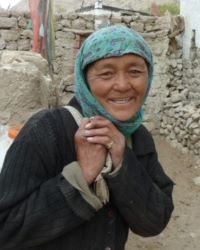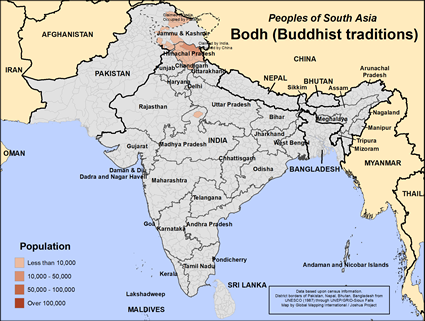Bodh (Buddhist traditions) in India

Photo Source:
Anonymous
|

Map Source:
People Group Location: Omid. Other geography / data: GMI. Map Design: Joshua Project
|
| People Name: | Bodh (Buddhist traditions) |
| Country: | India |
| 10/40 Window: | Yes |
| Population: | 118,000 |
| World Population: | 118,000 |
| Primary Language: | Ladakhi |
| Primary Religion: | Buddhism |
| Christian Adherents: | 0.35 % |
| Evangelicals: | 0.00 % |
| Scripture: | New Testament |
| Ministry Resources: | Yes |
| Jesus Film: | Yes |
| Audio Recordings: | Yes |
| People Cluster: | South Asia Tribal - other |
| Affinity Bloc: | South Asian Peoples |
| Progress Level: |
|
Introduction / History
The classification of the small Bodh group is extremely problematic. In India the government has granted scheduled tribe status to the Bhotia and also the Bodh of Himachal Pradesh. These two terms are generic names given to people of Tibetan origin across northern India and Nepal, and they are sometimes even used as a religious designation for all Buddhist people. Most likely the people who came from Tibet prior to 1962 are referred to as Bodhs, while those who have migrated across the border in the past sixty years are called Tibetans.
These broad classifications, however, are of little value when trying to determine ethnic and linguistic divisions among the cold and remote mountains in the northern part of the state. Even the people living in the three valleys given as the location of the Stod Bhoti (the Stod, Khoksar and Mayar valleys) may constitute three separate language groups and five sub-groups. Stod and Khoksar reportedly have 85 per cent mutual intelligibility, but Stod and Mayar only share 75 per cent intelligibility and there is a mere 62 per cent intelligibility between Khoksar and Mayar. Linguists say that there usually needs to be an 80 per cent mutual intelligibility between the speakers of two languages or dialects in order for them to be able to communicate in a meaningful manner.
Their region has been described as having "an inhospitable terrain with little vegetation as the area falls in the arid zone. It has very scanty rainfall.
What Are Their Lives Like?
Because of this difficult terrain, the Bodh people, be they herdsmen or farmers, are faced with a difficult life. They truly live by the sweat of their brows.
What Are Their Beliefs?
Tibetan Buddhism is the preferred religion of all Bodh people in India, although Hindu influence is increasing. They live in constant fear of evil spirits. They believe that they must vigilantly perform rituals and offerings to placate the deities, otherwise the spirit could take offence and bring disaster on their community. For example, Bodh households have a harsho (long pole) fixed in its courtyard with cloth tied around it to ward off the evil eye. They also have amulets to ward off the evil eye.
Tibetan Buddhist lamas are their sacred specialists. These religious experts perform exorcisms as needed. The Bodh are one of the most unreached Buddhist groups in the world.
What Are Their Needs?
The Bodh people desperately need to be freed from the powerful clutches of evil spirits. Only Jesus Christ can deliver them, but they must be willing to accept his lordship.
Prayer Points
Pray for them to understand and respond to Christ.
Pray God will have mercy on the Bodh, doing whatever it takes to put them in a position to receive him.
Ask God to open the hearts of the Bodh to the gospel.
Pray for an unstoppable movement to Christ among them.